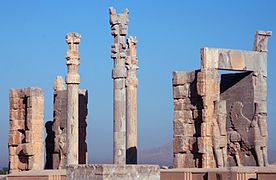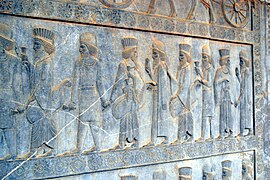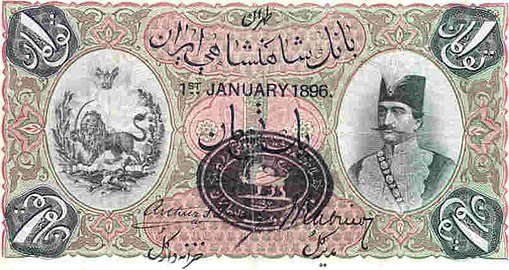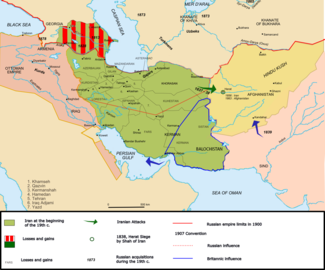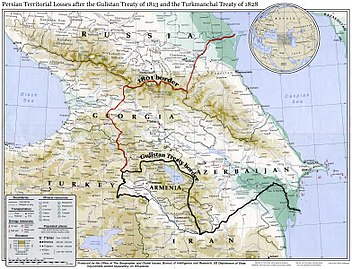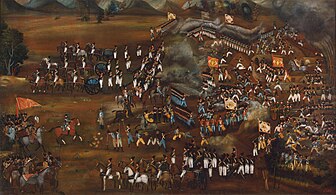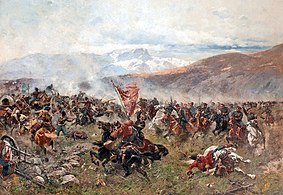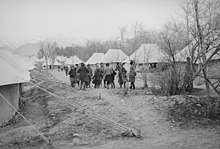History of Iran
| History of Iran |
|---|
 |
|
Timeline |
The history of Iran (or Persia, as it was commonly known in the Western world) is intertwined with that of Greater Iran, a sociocultural region spanning the area between Anatolia in the west and the Indus River and Syr Darya in the east, and between the Caucasus and Eurasian Steppe in the north and the Persian Gulf and the Gulf of Oman in the south. Central to this area is the modern-day country of Iran, which covers the bulk of the Iranian plateau.
Iran is home to one of the world's oldest continuous major civilizations, with historical and urban settlements dating back to 4000 BC.
The Iranian Empire proper begins in the Iron Age, following the influx of Iranian peoples. Iranian people gave rise to the Medes, the Achaemenid, Parthian, and Sasanian Empires of classical antiquity.
Once a major empire, Iran has endured invasions too, by the Macedonians, Arabs, Turks, and Mongols. Iran has continually reasserted its national identity throughout the centuries and has developed as a distinct political and cultural entity.
The Muslim conquest of Persia (633–654) ended the Sasanian Empire, and was a turning point in Iranian history. Islamization of Iran took place during the eighth to tenth centuries, leading to the eventual decline of Zoroastrianism in Iran as well as many of its dependencies. However, the achievements of the previous Persian civilizations were not lost but were to a great extent absorbed by the new Islamic polity and civilization.
Iran, with its long history of early cultures and empires, had suffered particularly hard during the Late Middle Ages and the early modern period. Many invasions of nomadic tribes, whose leaders became rulers in this country, affected it negatively.[5]
Iran was reunified as an independent state in 1501 by the Safavid dynasty, which set Shia Islam as the empire's official religion,[6] marking one of the most important turning points in the history of Islam.[7] Functioning again as a leading world power, this time amongst the neighbouring Ottoman Empire, its arch-rival for centuries, Iran had been a monarchy ruled by an emperor almost without interruption from 1501 until the 1979 Iranian Revolution, when Iran officially became an Islamic republic on 1 April 1979.[8][9]
Over the course of the first half of the 19th century, Iran lost many of its territories in the Caucasus, which had been a part of Iran for centuries,[10] comprising modern-day Eastern Georgia, Dagestan, Republic of Azerbaijan, and Armenia, to its rapidly expanding and emerging rival neighbor, the Russian Empire, following the Russo-Persian Wars between 1804–1813 and 1826–1828.[11]
Prehistory
Paleolithic
The earliest archaeological artifacts in Iran were found in the
Neolithic to Chalcolithic
Early agricultural communities such as Chogha Golan in 10,000 BC[16][17] along with settlements such as Chogha Bonut (the earliest village in Elam) in 8000 BC,[18][19] began to flourish in and around the Zagros Mountains region in western Iran.[20] Around about the same time, the earliest-known clay vessels and modelled human and animal terracotta figurines were produced at Ganj Dareh, also in western Iran.[20] There are also 10,000-year-old human and animal figurines from Tepe Sarab in Kermanshah Province among many other ancient artefacts.[21]
The south-western part of Iran was part of the
Bronze Age
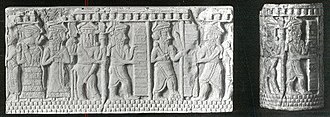

Parts of what is modern-day northwestern Iran was part of the Kura–Araxes culture (circa 3400 BC—ca. 2000 BC), that stretched up into the neighbouring regions of the Caucasus and Anatolia.[27][28]
Susa is one of the oldest-known settlements of Iran and the world. Based on C14 dating, the time of the foundation of the city is as early as 4395 BC,[22]: 45–46 a time right after the establishment of the ancient Sumerian city of Uruk in 4500 BC. The general perception among archaeologists is that Susa was an extension of the Sumerian city-state of Uruk, hence incorporating many aspects of Mesopotamian culture.[29][30] In its later history, Susa became the capital of Elam, which emerged as a state founded 4000 BC.[22]: 45–46 There are also dozens of prehistoric sites across the Iranian plateau pointing to the existence of ancient cultures and urban settlements in the fourth millennium BC.[23] One of the earliest civilizations on the Iranian plateau was the Jiroft culture in southeastern Iran in the province of Kerman.
It is one of the most artefact-rich archaeological sites in the Middle East. Archaeological excavations in Jiroft led to the discovery of several objects belonging to the 4th millennium BC.[31] There is a large quantity of objects decorated with highly distinctive engravings of animals, mythological figures, and architectural motifs. The objects and their iconography are considered unique. Many are made from chlorite, a grey-green soft stone; others are in copper, bronze, terracotta, and even lapis lazuli. Recent excavations at the sites have produced the world's earliest inscription which pre-dates Mesopotamian inscriptions.[32][33]
There are records of numerous other ancient civilizations on the
Russian historian Igor M. Diakonoff stated that the modern inhabitants of Iran are descendants of mainly non-Indo-European groups, more specifically of pre-Iranic inhabitants of the Iranian Plateau: "It is the autochthones of the Iranian plateau, and not the Proto-Indo-European tribes of Europe, which are, in the main, the ancestors, in the physical sense of the word, of the present-day Iranians."[34]
Early Iron Age

Records become more tangible with the rise of the Neo-Assyrian Empire and its records of incursions from the Iranian plateau. As early as the 20th century BC, tribes came to the Iranian plateau from the
Classical antiquity
Median and Achaemenid Empire (680–330 BC)
-
The tomb of Cyrus the Great
-
Ruins of the Gate of All Nations, Persepolis
-
Ruins of the Apadana, Persepolis
-
Depiction of unitedPersians at the Apadana, Persepolis
-
Ruins of the Tachara, Persepolis
In 646 BC, Assyrian king Ashurbanipal sacked Susa, which ended Elamite supremacy in the region.[37] For over 150 years Assyrian kings of nearby Northern Mesopotamia had been wanting to conquer Median tribes of Western Iran.[38] Under pressure from Assyria, the small kingdoms of the western Iranian plateau coalesced into increasingly larger and more centralized states.[37]
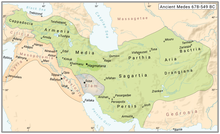
In the second half of the seventh century BC, the Medes gained their independence and were united by Deioces. In 612 BC, Cyaxares, Deioces' grandson, and the Babylonian king Nabopolassar invaded Assyria and laid siege to and eventually destroyed Nineveh, the Assyrian capital, which led to the fall of the Neo-Assyrian Empire.[39] Urartu was later on conquered and dissolved as well by the Medes.[40][41] The Medes are credited with founding Iran as a nation and empire, and established the first Iranian empire, the largest of its day until Cyrus the Great established a unified empire of the Medes and Persians, leading to the Achaemenid Empire (c.550–330 BC).
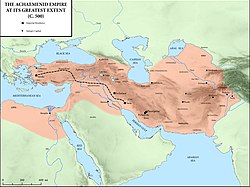
Cyrus the Great overthrew, in turn, the Median, Lydian, and Neo-Babylonian Empires, creating an empire far larger than Assyria. He was better able, through more benign policies, to reconcile his subjects to Persian rule; the longevity of his empire was one result. The Persian king, like the Assyrian, was also "King of Kings", xšāyaθiya xšāyaθiyānām (shāhanshāh in modern Persian) – "great king", Megas Basileus, as known by the Greeks.
Cyrus's son,
Darius' first capital was at Susa, and he started the building program at Persepolis. He rebuilt a canal between the Nile and the Red Sea, a forerunner of the modern Suez Canal. He improved the extensive road system, and it is during his reign that mentions are first made of the Royal Road (shown on map), a great highway stretching all the way from Susa to Sardis with posting stations at regular intervals. Major reforms took place under Darius. Coinage, in the form of the daric (gold coin) and the shekel (silver coin) was standardized (coinage had already been invented over a century before in Lydia c. 660 BC but not standardized),[42] and administrative efficiency increased.
The

In the late sixth century BC, Darius launched his European campaign, in which he defeated the
In 499 BC,

Greek conquest and Seleucid Empire (312 BC–248 BC)
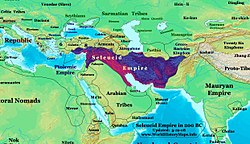
From 334 BC to 331 BC,
Greek language, philosophy, and art came with the colonists. During the Seleucid era, Greek became the common tongue of diplomacy and literature throughout the empire.
Parthian Empire (248 BC–224 AD)
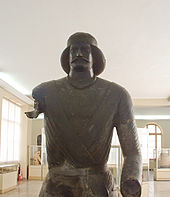

The Parthian Empire—ruled by the Parthians, a group of northwestern Iranian people—was the realm of the Arsacid dynasty. This latter reunited and governed the Iranian plateau after the Parni conquest of Parthia and defeating the Seleucid Empire in the late third century BC. It intermittently controlled Mesopotamia between c. 150 BC and 224 AD and absorbed Eastern Arabia.
Parthia was the eastern arch-enemy of the Roman Empire and it limited Rome's expansion beyond Cappadocia (central Anatolia). The Parthian armies included two types of cavalry: the heavily armed and armored cataphracts and the lightly armed but highly-mobile mounted archers.
For the Romans, who relied on heavy infantry, the Parthians were too hard to defeat, as both types of cavalry were much faster and more mobile than foot soldiers. The Parthian shot used by the Parthian cavalry was most notably feared by the Roman soldiers, which proved pivotal in the crushing Roman defeat at the Battle of Carrhae. On the other hand, the Parthians found it difficult to occupy conquered areas as they were unskilled in siege warfare. Because of these weaknesses, neither the Romans nor the Parthians were able completely to annex each other's territory.
The Parthian empire subsisted for five centuries, longer than most Eastern Empires. The end of this empire came at last in 224 AD, when the empire's organization had loosened and the last king was defeated by one of the empire's vassal peoples, the Persians under the Sasanians. However, the Arsacid dynasty continued to exist for centuries onwards in
Sasanian Empire (224–651 AD)
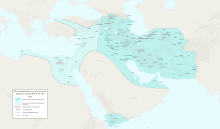
The first shah of the Sasanian Empire, Ardashir I, started reforming the country economically and militarily. For a period of more than 400 years, Iran was once again one of the leading powers in the world, alongside its neighbouring rival, the Roman and then Byzantine Empires.[51][52] The empire's territory, at its height, encompassed all of today's Iran, Iraq, Azerbaijan, Armenia, Georgia, Abkhazia, Dagestan, Lebanon, Jordan, Palestine, Israel, parts of Afghanistan, Turkey, Syria, parts of Pakistan, Central Asia, Eastern Arabia, and parts of Egypt.
Most of the Sasanian Empire's lifespan was overshadowed by the frequent
Eastern Arabia was conquered early on. During Khosrow II's rule in 590–628, Egypt, Jordan, Palestine and Lebanon were also annexed to the Empire. The Sassanians called their empire Erânshahr ("Dominion of the Aryans", i.e., of Iranians).[53]
A chapter of Iran's history followed after roughly six hundred years of conflict with the Roman Empire. During this time, the Sassanian and Romano-Byzantine armies clashed for influence in Anatolia, the western Caucasus (mainly Lazica and the Kingdom of Iberia; modern-day Georgia and Abkhazia), Mesopotamia, Armenia and the Levant. Under Justinian I, the war came to an uneasy peace with payment of tribute to the Sassanians.
However, the Sasanians used the deposition of the Byzantine emperor
The Sasanian era, encompassing the length of
This influence carried forward to the Muslim world. The dynasty's unique and aristocratic culture transformed the Islamic conquest and destruction of Iran into a Persian Renaissance.[55] Much of what later became known as Islamic culture, architecture, writing, and other contributions to civilization, were taken from the Sassanian Persians into the broader Muslim world.[59]

Medieval period
Early Islamic period
Islamic conquest of Persia (633–651)
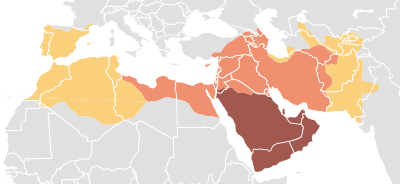
In 633, when the Sasanian king
Yazdegerd III fled from one district to another until a local miller killed him for his purse at Merv in 651.[60] By 674, Muslims had conquered Greater Khorasan (which included modern Iranian Khorasan province and modern Afghanistan and parts of Transoxiana).
The Muslim conquest of Persia ended the Sasanian Empire and led to the eventual decline of the Zoroastrian religion in Persia. Over time, the majority of Iranians converted to Islam. Most of the aspects of the previous Persian civilizations were not discarded but were absorbed by the new Islamic polity. As Bernard Lewis has commented:
"These events have been variously seen in Iran: by some as a blessing, the advent of the true faith, the end of the age of ignorance and heathenism; by others as a humiliating national defeat, the conquest and subjugation of the country by foreign invaders. Both perceptions are of course valid, depending on one's angle of vision."[61]
Umayyad era and Muslim incursions into the Caspian coast
After the fall of the Sasanian Empire in 651, the
During the Umayyad Caliphate, the Arab conquerors imposed Arabic as the primary language of the subject peoples throughout their empire. Al-Hajjaj ibn Yusuf, who was not happy with the prevalence of the Persian language in the divan, ordered the official language of the conquered lands to be replaced by Arabic, sometimes by force.[63] In al-Biruni's From The Remaining Signs of Past Centuries for example it is written:
"When
Khwarazmia with a military expedition and conquered it for the second time, he swiftly killed whoever wrote the Khwarazmian native language that knew of the Khwarazmian heritage, history, and culture. He then killed all their Zoroastrian priests and burned and wasted their books, until gradually the illiterate only remained, who knew nothing of writing, and hence their history was mostly forgotten."[64]
There are a number of historians who see the rule of the Umayyads as setting up the "dhimmah" to increase taxes from the dhimmis to benefit the Muslim Arab community financially and by discouraging conversion.[65] Governors lodged complaints with the caliph when he enacted laws that made conversion easier, depriving the provinces of revenues.
In the 7th century, when many non-Arabs such as Persians entered Islam, they were recognized as mawali ("clients") and treated as second-class citizens by the ruling Arab elite until the end of the Umayyad Caliphate. During this era, Islam was initially associated with the ethnic identity of the Arab and required formal association with an Arab tribe and the adoption of the client status of mawali.[65] The half-hearted policies of the late Umayyads to tolerate non-Arab Muslims and Shias had failed to quell unrest among these minorities.
However, all of Iran was still not under Arab control, and the region of
With the death of the Umayyad Caliph Hisham ibn Abd al-Malik in 743, the Islamic world was launched into civil war. Abu Muslim was sent to Khorasan by the Abbasid Caliphate initially as a propagandist and then to revolt on their behalf. He took Merv defeating the Umayyad governor there Nasr ibn Sayyar. He became the de facto Abbasid governor of Khurasan. During the same period, the Dabuyid ruler Khurshid declared independence from the Umayyads but was shortly forced to recognize Abbasid authority. In 750, Abu Muslim became the leader of the Abbasid army and defeated the Umayyads at the Battle of the Zab. Abu Muslim stormed Damascus, the capital of the Umayyad caliphate, later that year.
Abbasid period and autonomous Iranian dynasties
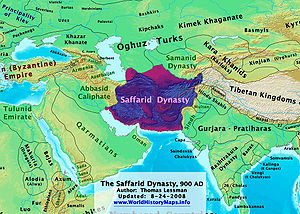
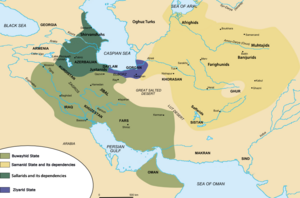
The Abbasid army consisted primarily of Khorasanians and was led by an Iranian general,
One of the first changes the Abbasids made after taking power from the Umayyads was to move the empire's capital from
The Abbasids established the position of vizier like Barmakids in their administration, which was the equivalent of a "vice-caliph", or second-in-command. Eventually, this change meant that many caliphs under the Abbasids ended up in a much more ceremonial role than ever before, with the vizier in real power. A new Persian bureaucracy began to replace the old Arab aristocracy, and the entire administration reflected these changes, demonstrating that the new dynasty was different in many ways from the Umayyads.[69]
By the 9th century, Abbasid control began to wane as regional leaders sprang up in the far corners of the empire to challenge the central authority of the Abbasid caliphate.[69] The Abbasid caliphs began enlisting mamluks, Turkic-speaking warriors, who had been moving out of Central Asia into Transoxiana as slave warriors as early as the 9th century. Shortly thereafter the real power of the Abbasid caliphs began to wane; eventually, they became religious figureheads while the warrior slaves ruled.[67]

The 9th century also saw the revolt by native Zoroastrians, known as the
As the power of the Abbasid caliphs diminished, a series of dynasties rose in various parts of Iran, some with considerable influence and power. Among the most important of these overlapping dynasties were the
By the early 10th century, the Abbasids almost lost control to the growing Persian faction known as the
During the
Islamic golden age, Shu'ubiyya movement and Persianization process
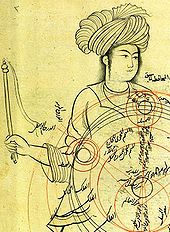
Although Persians adopted the religion of their conquerors, over the centuries they worked to protect and revive their distinctive language and culture, a process known as Persianization. Arabs and Turks participated in this attempt.[75][76][77]
In the 9th and 10th centuries, non-Arab subjects of the
The
The culmination of the
"Iran was indeed Islamized, but it was not Arabized. Persians remained Persians. And after an interval of silence, Iran re-emerged as a separate, different and distinctive element within Islam, eventually adding a new element even to Islam itself. Culturally, politically, and most remarkable of all even religiously, the Iranian contribution to this new Islamic civilization is of immense importance. The work of Iranians can be seen in every field of cultural endeavour, including Arabic poetry, to which poets of Iranian origin composing their poems in Arabic made a very significant contribution. In a sense, Iranian Islam is a second advent of Islam itself, a new Islam sometimes referred to as Islam-i Ajam. It was this Persian Islam, rather than the original Arab Islam, that was brought to new areas and new peoples: to the Turks, first in Central Asia and then in the Middle East in the country which came to be called Turkey, and of course to India. The Ottoman Turks brought a form of Iranian civilization to the walls of Vienna..."
The
The most important scholars of almost all of the Islamic sects and schools of thought were Persian or lived in Iran, including the most notable and reliable
Persianate states and dynasties (977–1219)

In 977, a Turkic governor of the Samanids,
The Ghaznavids are generally credited with launching Islam into a mainly
The

The founder of the dynasty,
When Malik Shah I died in 1092, the empire split as his brother and four sons quarreled over the apportioning of the empire among themselves. In Anatolia, Malik Shah I was succeeded by
A serious internal threat to the Seljuqs during their reign came from the Nizari Ismailis, a secret sect with headquarters at Alamut Castle between Rasht and Tehran. They controlled the immediate area for more than 150 years and sporadically sent out adherents to strengthen their rule by murdering important officials. Several of the various theories on the etymology of the word assassin derive from these killers.[67]
Parts of northwestern Iran were conquered in the early 13th century AD by the
Mongol conquest and rule (1219–1370)
Mongol invasion (1219–1221)


The
The
While Genghis Khan was conquering Transoxania and Persia, several Chinese who were familiar with gunpowder were serving in Genghis's army.[91] "Whole regiments" entirely made out of Chinese were used by the Mongols to command bomb hurling trebuchets during the invasion of Iran.[92] Historians have suggested that the Mongol invasion had brought Chinese gunpowder weapons to Central Asia. One of these was the huochong, a Chinese mortar.[93] Books written around the area afterward depicted gunpowder weapons which resembled those of China.[94]
Destruction under the Mongols
Before his death in 1227, Genghis had reached western Azerbaijan, pillaging and burning many cities along the way after entering into Iran from its north east.
The Mongol invasion was by and large disastrous to the Iranians. Although the Mongol invaders eventually converted to Islam and accepted the culture of Iran, the Mongol destruction in Iran and other regions of the Islamic heartland (particularly the historical Khorasan region, mainly in Central Asia) marked a major change of direction for the region. Much of the six centuries of Islamic scholarship, culture, and infrastructure was destroyed as the invaders leveled cities, burned libraries, and in some cases replaced mosques with Buddhist temples.[95][96][97]
The Mongols killed many Iranian civilians. Destruction of qanat irrigation systems in the north east of Iran destroyed the pattern of relatively continuous settlements, producing many abandoned towns which were relatively quite good with irrigation and agriculture.[98]
Ilkhanate (1256–1335)
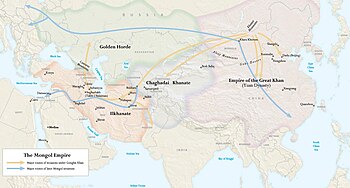
After Genghis's death, Iran was ruled by several Mongol commanders. Genghis' grandson,
Hulagu Khan seized Baghdad in 1258 and put the last Abbasid caliph to death. The westward advance of his forces was stopped by the
The rule of Hulagu's great-grandson,
Items from India, China, and Iran passed easily across the Asian steppes, and these contacts culturally enriched Iran. For example, Iranians developed a new style of painting based on a unique fusion of solid, two-dimensional Mesopotamian painting with the feathery, light brush strokes and other motifs characteristic of China. After Ghazan's nephew
The mid-14th-century Black Death killed about 30% of the country's population.[99]
Sunnism and Shiism in pre-Safavid Iran

Prior to the rise of the Safavid Empire, Sunni Islam was the dominant religion, accounting for around 90% of the population at the time. According to
The domination of the Sunni creed during the first nine Islamic centuries characterized the religious history of Iran during this period. There were however some exceptions to this general domination which emerged in the form of the
Apart from this domination there existed, firstly, throughout these nine centuries, Shia inclinations among many Sunnis of this land and, secondly, original
During the 10th and 11th centuries,
After the Mongol raid and fall of the Abbasids, Sunni hierarchies faltered. Not only did they lose the caliphate but also the status of official madhhab. Their loss was the gain of Shia, whose centre wasn't in Iran at that time. Several local Shia dynasties like Sarbadars were established during this time.[citation needed]
The main change occurred in the beginning of the 16th century, when
Timurid Empire (1370–1507)
Iran remained divided until the arrival of Timur, a Turco-Mongol[102] belonging to the Timurid dynasty. Like its predecessors, the Timurid Empire was also part of the Persianate world. After establishing a power base in Transoxiana, Timur invaded Iran in 1381 and eventually conquered most of it. Timur's campaigns were known for their brutality; many people were slaughtered and several cities were destroyed.[103]
His regime was characterized by tyranny and bloodshed, but also by its inclusion of Iranians in administrative roles and its promotion of architecture and poetry. His successors, the Timurids, maintained a hold on most of Iran until 1452, when they lost the bulk of it to
Kara Koyunlu
The Kara Koyunlu were a
Ak Koyunlu

Aq Qoyunlu were Turkmen
Early modern period
Persia underwent a revival under the
Safavid Empire (1501–1736)
The Safavid dynasty was one of the most significant ruling dynasties of
The Safavid ruling dynasty was founded by Ismāil, who styled himself Shāh Ismāil I.[115] Practically worshipped by his Qizilbāsh followers, Ismāil invaded Shirvan to avenge the death of his father, Shaykh Haydar, who had been killed during his siege of Derbent, in Dagestan. Afterwards he went on a campaign of conquest, and following the capture of Tabriz in July 1501, he enthroned himself as the Shāh of Iran,[116]: 324 [117][118] minted coins in this name, and proclaimed Shi'ism the official religion of his domain.[6]
Although initially the masters of Azerbaijan and southern Dagestan only, the Safavids had, in fact, won the struggle for power in Persia which had been going on for nearly a century between various dynasties and political forces following the fragmentation of the

Shah

The greatest of the Safavid monarchs,
He expanded commercial links with the Dutch East India Company and established firm links with the European royal houses, which had been initiated by Ismail I earlier on by the Habsburg–Persian alliance. Thus Abbas I was able to break the dependence on the Qizilbash for military might and therefore was able to centralize control. The Safavid dynasty had already established itself during Shah Ismail I, but under Abbas I it really became a major power in the world along with its archrival the Ottoman Empire, against whom it became able to compete with on equal foot. It also started the promotion of tourism in Iran. Under their rule Persian Architecture flourished again and saw many new monuments in various Iranian cities, of which Isfahan is the most notable example.
Except for Shah Abbas the Great, Shah Ismail I, Shah Tahmasp I, and Shah Abbas II, many of the Safavid rulers were ineffectual, often being more interested in their women, alcohol and other leisure activities. The end of Abbas II's reign in 1666, marked the beginning of the end of the Safavid dynasty. Despite falling revenues and military threats, many of the later shahs had lavish lifestyles. Shah Soltan Hosain (1694–1722) in particular was known for his love of wine and disinterest in governance.[123]
The declining country was repeatedly raided on its frontiers. Finally,
Nader Shah and his successors
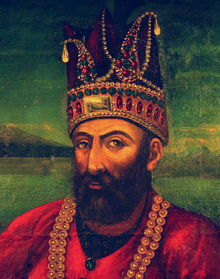
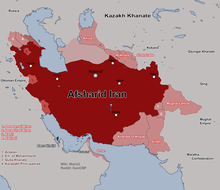
Iran's territorial integrity was restored by a native Iranian
Nader's death was followed by a
Late modern period
Qajar dynasty (1796–1925)
-
Qajar era currency bill with depiction of Naser al-Din Shah Qajar.
-
A map of Iran under the Qajar dynasty in the 19th century.
-
A map showing the 19th-century northwestern borders of Iran, comprising modern-day eastern Georgia, Dagestan, Armenia, and the Republic of Azerbaijan, before being ceded to the neighboring Russian Empire by the Russo-Iranian wars.
Agha Mohammad Khan subsequently demanded that Heraclius II renounce
Agha Mohammad Shah was later assassinated while preparing a second expedition against Georgia in 1797 in
The area to the north of the river Aras, among which the territory of the contemporary republic of Azerbaijan, eastern Georgia, Dagestan, and Armenia were Iranian territory until they were occupied by Russia in the course of the 19th century.[144]
-
Painting showing theState Hermitage Museum.
-
Storming of Lankaran, 1812. Painted by Franz Roubaud.
Migration of Caucasian Muslims
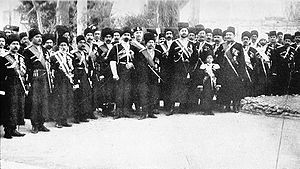
Following the official loss of vast territories in the Caucasus, major demographic shifts were bound to take place. Following the 1804–1814 war, but also per the 1826–1828 war which ceded the last territories, large migrations, so-called
After the
From 1864 until the early 20th century,
Many of these migrants would prove to play a pivotal role in further Iranian history, as they formed most of the ranks of the Persian Cossack Brigade, which was established in the late 19th century.[149] The initial ranks of the brigade would be entirely composed of Circassians and other Caucasian Muhajirs.[149] This brigade would prove decisive in the following decades in Qajar history.Furthermore, the 1828 Treaty of Turkmenchay included the official rights for the Russian Empire to encourage settling of Armenians from Iran in the newly conquered Russian territories.[150][151] Until the mid-fourteenth century, Armenians had constituted a majority in Eastern Armenia.[152] At the close of the fourteenth century, after
At the time of the Russian invasion of Iran, some 80% of the population of
Fath Ali Shah's reign saw increased diplomatic contacts with the West and the beginning of intense European diplomatic rivalries over Iran. His grandson Mohammad Shah, who succeeded him in 1834, fell under the Russian influence and made two unsuccessful attempts to capture Herat. When Mohammad Shah died in 1848 the succession passed to his son Naser al-Din Shah Qajar, who proved to be the ablest and most successful of the Qajar sovereigns. He founded the first modern hospital in Iran.[162]
Constitutional Revolution and deposition
The Great Persian Famine of 1870–1871 is believed to have caused the death of two million people.[163]
A new era in the history of Persia dawned with the Persian Constitutional Revolution against the Shah in the late 19th and early 20th centuries. The Shah managed to remain in power, granting a limited constitution in 1906 (making the country a constitutional monarchy). The first Majlis (parliament) was convened on October 7, 1906.
The discovery of
During World War I, the country was occupied by British, Ottoman and Russian forces but was essentially neutral (see Persian Campaign). In 1919, after the Russian Revolution and their withdrawal, Britain attempted to establish a protectorate in Persia, which was unsuccessful.
Finally, the
Pahlavi era (1925–1979)
Reza Shah (1925–1941)
To his supporters, his reign brought "law and order, discipline, central authority, and modern amenities – schools, trains, buses, radios, cinemas, and telephones".[167] However, his attempts of modernisation have been criticised for being "too fast"[168] and "superficial",[169] and his reign a time of "oppression, corruption, taxation, lack of authenticity" with "security typical of police states."[167]
Many of the new laws and regulations created resentment among devout Muslims and the clergy. For example, mosques were required to use chairs; most men were required to wear western clothing, including a hat with a brim; women were encouraged to discard the
World War II
While
At the
Mohammad-Reza Shah (1941–1979)

Initially there were hopes that post-occupation Iran could become a
In 1951 Prime Minister
1953: U.S. aided coup removes Mosaddeq
Shortly thereafter on August 19 a successful
Iran was ruled as an autocracy under the Shah with American support from that time until the revolution. The Iranian government entered into agreement with an international consortium of foreign companies which ran the Iranian oil facilities for the next 25 years, splitting profits fifty-fifty with Iran but not allowing Iran to audit their accounts or have members on their board of directors. In 1957 martial law was ended after 16 years and Iran became closer to the West, joining the
The core of this program was land reform. Modernization and economic growth proceeded at an unprecedented rate, fueled by Iran's vast petroleum reserves, the third-largest in the world. However, the reforms, including the White Revolution, did not greatly improve economic conditions and the liberal pro-Western policies alienated certain
Two years later, premier
Nearly a hundred Iran political prisoners were killed by the SAVAK during the decade before the revolution and many more were arrested and tortured.[177] The Islamic clergy, headed by the Ayatollah Ruhollah Khomeini (who had been exiled in 1964), were becoming increasingly vociferous.
Iran greatly increased its defense budget and by the early 1970s was the region's strongest military power. Bilateral relations with Iraq were not good, mainly due to a dispute over the Shatt al-Arab waterway. In November 1971, Iranian forces seized control of three islands at the mouth of the Persian Gulf; in response, Iraq expelled thousands of Iranian nationals. Following a number of clashes in April 1969, Iran abrogated the 1937 accord and demanded a renegotiation.
In mid-1973, the Shah returned the oil industry to national control. Following the Arab-Israeli War of October 1973, Iran did not join the Arab oil embargo against the West and Israel. Instead, it used the situation to raise oil prices, using the money gained for modernization and to increase defense spending.
A border dispute between Iraq and Iran was resolved with the signing of the
Contemporary period
Revolution and the Islamic Republic (1979 to present)
The Iranian Revolution, also known as the Islamic Revolution,
In between, Mohammad Reza Pahlavi left the country for exile in January 1979 after strikes and demonstrations paralyzed the country, and on February 1, 1979, Ayatollah Khomeini returned to Tehran.[180] The final collapse of the Pahlavi dynasty occurred shortly after on February 11 when Iran's military declared itself "neutral" after guerrillas and rebel troops overwhelmed troops loyal to the Shah in armed street fighting. Iran officially became an Islamic Republic on April 1, 1979, when Iranians overwhelmingly approved a national referendum to make it so.[181]
Ideology of the 1979 Iranian Revolution
The ideology of the revolutionary government was populist, nationalist and most of all
Iran's rapidly modernising, capitalist economy was replaced by populist and Islamic economic and cultural policies. Much industry was
The Islamic revolution also created great impact around the world. In the non-Muslim world it has changed the image of Islam, generating much interest in the politics and spirituality of Islam,[183] along with "fear and distrust towards Islam" and particularly the Islamic Republic and its founder.[184]
Khomeini (1979–1989)
Khomeini served as leader of the revolution or as Supreme Leader of Iran from 1979 to his death on June 3, 1989. This era was dominated by the consolidation of the revolution into a theocratic republic under Khomeini, and by the costly and bloody war with Iraq.
The consolidation lasted until 1982–3,
In the summer of 1979 a new constitution giving Khomeini a powerful post as guardian jurist
Iran hostage crisis (1979–1981)
An early event in the history of the Islamic republic that had a long-term impact was the Iran hostage crisis. Following the admitting of the former Shah of Iran into the United States for cancer treatment, on November 4, 1979, Iranian students seized US embassy personnel, labeling the embassy a "den of spies."[188] Fifty-two hostages were held for 444 days until January 1981.[189] An American military attempt to rescue the hostages failed.[190]
The takeover was enormously popular in Iran, where thousands gathered in support of the hostage takers, and it is thought to have strengthened the prestige of the
Iran–Iraq War (1980–1988)

During this political and social crisis, Iraqi leader Saddam Hussein attempted to take advantage of the disorder of the Revolution, the weakness of the Iranian military and the revolution's antagonism with Western governments. The once-strong Iranian military had been disbanded during the revolution, and with the Shah ousted, Hussein had ambitions to position himself as the new strong man of the Middle East. He sought to expand Iraq's access to the Persian Gulf by acquiring territories that Iraq had claimed earlier from Iran during the Shah's rule.
Of chief importance to Iraq was
Although Saddam Hussein's forces made several early advances, Iranian forces had pushed the Iraqi army back into Iraq by 1982. Khomeini sought to
Tens of thousands of Iranian civilians and military personnel were killed when Iraq used
There were more than 182,000 Kurdish victims[192] of Iraq's chemical weapons during the eight-year war. The total Iranian casualties of the war were estimated to be between 500,000 and 1,000,000. Almost all relevant international agencies have confirmed that Saddam engaged in chemical warfare to blunt Iranian human wave attacks; these agencies unanimously confirmed that Iran never used chemical weapons during the war.[193][194][195][196]
Starting on 19 July 1988 and lasting for about five months the
Khamenei (1989–present)
On his deathbed in 1989,
Rafsanjani: pragmatic conservativism (1989–1997)
Ali-
Iran in the 1990s had a greater secular behavior and admiration for Western popular culture than in the previous decades. This admiration had become a way in which the urban population expressed their resentment at the invasive Islamic policies of the government.
Khatami: reformers and conservatives struggle (1997–2005)
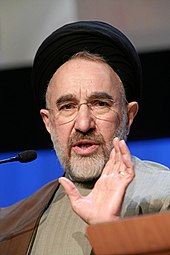
President Rafsanjani's economic policies led to stronger relations with the outside world. But his government's relaxation of the enforcement of certain regulations on social behavior were met with some responses of widespread disenchantment among the general population with the ulama as rulers of the country.
Khatami was re-elected in June 2001 but his efforts were repeatedly blocked by the conservatives in the parliament. Conservative elements within Iran's government moved to undermine the reformist movement, banning liberal newspapers and disqualifying candidates for parliamentary elections. This clampdown on dissent, combined with the failure of Khatami to reform the government, led to growing political apathy among Iran's youth.
In June 2003, anti-government protests by several thousand students took place in Tehran.
Ahmadinejad: hardline conservatism (2005–2009)
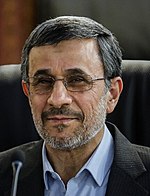
In the
During this time, the American invasion of Iraq, the overthrow of
During 2005 and 2006, there were claims that the United States and Israel were planning to attack Iran, with the most cited reason being Iran's civilian nuclear energy program which the United States and some other states fear could lead to a nuclear weapons program. China and Russia opposed military action of any sort and opposed economic sanctions. Khamenei issued a fatwa forbidding the production, stockpiling and use of nuclear weapons. The fatwa was cited in an official statement by the Iranian government at an August 2005 meeting of the International Atomic Energy Agency (IAEA) in Vienna.[213][214]
In 2009,
Rouhani: pragmatism (2013–2021)
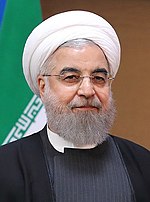
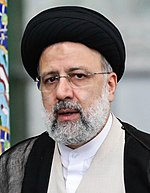
On 15 June 2013, Hassan Rouhani won the presidential election in Iran, with a total number of 36,704,156 ballots cast; Rouhani won 18,613,329 votes. In his press conference one day after election day, Rouhani reiterated his promise to recalibrate Iran's relations with the world.[218]
On April 2, 2015, following eight days of tortuous discussions in Switzerland, which lasted through the night, Iran and six world powers (United States, United Kingdom, France, China and Russia plus Germany) agreed on the outlines of an understanding to limit Iran's nuclear programs, negotiators indicated, as both sides prepared for announcements. Iranian Foreign Minister Mohammad
Reading out a joint statement, European Union foreign policy chief Federica Mogherini hailed what she called a "decisive step" after more than a decade of work. Iranian Foreign Minister Mohammad Javad Zarif followed with the same statement in Persian. U.S. Secretary of State John Kerry and the top diplomats of Britain, France and Germany also briefly took the stage behind them. The deal is intended to be a provisional framework for a comprehensive agreement and was signed in 2015, and marked a significant breakthrough in the 12-year history of negotiations with Iran over its nuclear programme.[219]
When
The Iranian-backed group known as Kataib Hezbollah attacked the United States embassy in Baghdad on December 31, 2019.[221]
On January 3, 2020, the United States military executed a drone strike at
On 3 August 2021 Ebrahim Raisi was elected 8th President of Iran.[223]
Ebrahim Raisi (2021–)
Beginning on 16 September 2022
On 1 April 2024, Israel's air strike on an Iranian consulate building in the Syrian capital Damascus killed an important senior commander of the Islamic Revolutionary Guards Corps (IRGC), Brig Gen Mohammad Reza Zahedi.[227] In retaliation for the Israeli strike, Iran attacked Israel with over 300 drones and missiles on 13 April. However, the Iranian attack was intercepted either outside Israeli airspace or over the country itself.[228] It was followed by a retaliatory missile strike by Israel on Isfahan, Iran on 19 April.[229]
See also
- List of monarchs of Persia
- Outline of Iran
- Politics of Iran
- Iranian religions
- Safavid conversion of Iran to Shia Islam
- Timeline of Tehran
- Timeline of the Iranian Revolution
- Timeline of Iranian history
- General
Notes
- Transcaucasia.[159] Unlike Armenians and Georgians, the Tatars did not have their own alphabet and used the Perso-Arabic script.[159] After 1918 with the establishment of the Azerbaijan Democratic Republic, and "especially during the Soviet era", the Tatar group identified itself as "Azerbaijani".[159] Prior to 1918 the word "Azerbaijan" exclusively referred to the Iranian province of Azarbayjan.[160]
References
- ^ People, "New evidence: modern civilization began in Iran", 10 Aug 2007 Archived 24 February 2021 at the Wayback Machine, retrieved 1 October 2007
- ^ Azadpour, M. "HEGEL, GEORG WILHELM FRIEDRICH". Encyclopædia Iranica. Archived from the original on 11 April 2015. Retrieved 11 April 2015.
- ^ https://www.britannica.com/ebc/article-9371723 Archived 2008-04-29 at the Wayback Machine Encyclopædia Britannica Concise Encyclopedia Article: Media
- ISBN 978-0-8160-5722-1. Archived from the original on 26 January 2021. Retrieved 17 October 2020.)
{{cite book}}: CS1 maint: multiple names: authors list (link - ISBN 978-1-107-50718-0.
- ^ Encyclopedia of Islam, 2nd edition
- ^ "The Islamic World to 1600", Applied History Research Group, University of Calgary, 1998 Archived 2008-06-12 at the Wayback Machine, retrieved 1 October 2007
- ^ "Iran Islamic Republic", Archived 2006-03-16 at the Wayback Machine, Encyclopædia Britannica, retrieved 23 January 2008
- ^ a b Encyclopædia Britannica 23 January 2008 Archived December 15, 2007, at the Wayback Machine
- ^ a b Fisher et al. 1991, pp. 329–330.
- ISBN 978-1-59884-948-6.
- ^ Ancient Iran, Encyclopædia Britannica, www.britannica.com
- S2CID 212851965.
- ISBN 1-84217-121-6
- ^ TRINKAUS, E.; BIGLARI, F. "Middle Paleolithic Human Remains from Bisitun Cave, Iran". Archived from the original on 27 July 2016. Retrieved 6 November 2021.
- ^ "Early humans in Iran were growing wheat 12,000 years ago". NBC.news. 5 July 2013. Archived from the original on 2 November 2020. Retrieved 10 September 2014.
- ^ Riehl, Simone. "Emergence of Agriculture in the Foothills of the Zagros Mountains of Iran (Supplement)". www.researchgate.net. Archived from the original on 3 May 2019. Retrieved 1 March 2015.
- ^ "Excavations at Chogha Bonut: The earliest village in Susiana". University of Chicago. Archived from the original on 25 July 2013. Retrieved 21 June 2013.
- ^ Hole, Frank (20 July 2004). "Neolithic Age in Iran". Encyclopedia Iranica. Encyclopaedia Iranica Foundation. Archived from the original on 23 October 2012. Retrieved 9 August 2012.
- ^ a b "Iran, 8000–2000 BC". The Timeline of Art History. The Metropolitan Museum of Art. October 2000. Archived from the original on 5 March 2001. Retrieved 9 August 2008.
- ^ "Ancient Iran Museum". Ali Majdfar, photography. Archived from the original on 26 July 2013. Retrieved 27 March 2008.
{{cite web}}: CS1 maint: others (link) - ^ ISBN 0-521-56358-5.
- ^ a b Xinhua, "New evidence: modern civilization began in Iran", 10 Aug 2007 Archived 23 November 2016 at the Wayback Machine, retrieved 1 October 2007
- ^ K. Kris Hirst. "Chogha Mish (Iran)". Archived from the original on 6 November 2013. Retrieved 11 June 2010.
- ^ "Penn Museum – University of Pennsylvania Museum of Archaeology and Anthropology". Archived from the original on 16 December 2008.
- JSTOR 124833.
- ISBN 978-0-924171-50-5. Archivedfrom the original on 13 September 2020. Retrieved 8 May 2016., page 44
- ISBN 978-1-134-44027-6. Archivedfrom the original on 6 September 2020. Retrieved 8 May 2016., page 163
- ^ Algaze, Guillermo. 2005. The Uruk World System: The Dynamics of Expansion of Early Mesopotamian Civilization
- ISBN 978-1-885923-66-0. Archived(PDF) from the original on 21 March 2014.
- ^ "5000-Y-Old Inscribed Tablets Discovered in Jiroft". Archived from the original on 11 May 2011.
- ^ "New Discoveries in Jiroft May Change History of Civilization". Cultural Heritage News Agency. 26 January 2006. Archived from the original on 11 April 2008. Retrieved 16 March 2023.
- ^ Yarshater, Yarshater. "Iranian history". Encyclopædia Iranica. Archived from the original on 3 February 2021. Retrieved 23 June 2008.
- ^ Diakonoff, I., M., "Media", Cambridge History of Iran, II, Cambridge, 1985, p.43 [within the pp.36–148]. This paper is cited in the Journal of Eurasian Studies on page 51.
- ^ Lackenbacher, Sylvie. "Elam". Encyclopædia Iranica. Archived from the original on 18 November 2020. Retrieved 23 June 2008.
- ^ ^ Bahman Firuzmandi "Mad, Hakhamanishi, Ashkani, Sasani" pp. 20
- ^ a b "Iran, 1000 BC–1 AD". The Timeline of Art History. The Metropolitan Museum of Art. October 2000. Archived from the original on 25 January 2021. Retrieved 9 August 2008.
- ^ Medvedskaya, I.N. (January 2002). "The Rise and Fall of Media". International Journal of Kurdish Studies. BNET. Archived from the original on 28 March 2008. Retrieved 10 August 2008.
- ISBN 978-0-275-96890-8.
- ^ Urartu – Lost Kingdom of Van Archived 2015-07-02 at the Wayback Machine
- ^ "Urartu Civilization – All About Turkey". Archived from the original on 1 July 2015. Retrieved 18 June 2015.
- ^ "Forgotten Empire— the world of Ancient Persia". The British Museum. 2005. Archived from the original on 23 April 2007. Retrieved 16 March 2023.
- ^ Hooker, Richard (1996). "The Persians". Archived from the original on 29 August 2006. Retrieved 20 August 2006.
- ^ "Engineering an Empire: The Persians | Anthropology.net". Archived from the original on 10 January 2007. Retrieved 13 March 2007.
- ^ "Greek-Persian Wars (490 bce–479 bce) - Gale Encyclopedia of World History: War - Encyclopedia.com". Archived from the original on 4 September 2009. Retrieved 13 March 2007.
- ^ Benevolent Persian Empire Archived 2005-09-07 at the Wayback Machine
- ^ a b c Roisman & Worthington 2011, p. 345.
- ISBN 978-1-84884-630-2.
- ISBN 978-0-19-045183-7. Archivedfrom the original on 23 September 2020. Retrieved 12 September 2016.
- ^ Roisman & Worthington 2011, pp. 135–138, 342–345.
- ISBN 0827611552
- ISBN 075465740X
- ^ Garthwaite, Gene R., The Persians, p. 2
- ^ J. B. Bury, p.109.
- ^ a b Durant.
- ^ "Compareti – Sasanians in Africa – Transoxiana 4". Archived from the original on 28 May 2008. Retrieved 5 March 2007.
- ^ Sarfaraz, pp. 329–330.
- ^ "Iransaga – Persian Art, The Sassanians". Archived from the original on 23 November 2019. Retrieved 5 March 2007.
- ^ Zarinkoob, p.305.
- ^ "Iran". Encyclopædia Britannica. Archived from the original on 13 August 2013. Retrieved 21 June 2007.
- ^ a b Lewis, Bernard. "Iran in history". Tel Aviv University. Archived from the original on 29 April 2007. Retrieved 3 April 2007.
- ^ Hawting G., The First Dynasty of Islam. The Umayyad Caliphate AD 661–750, (London) 1986, pp. 63–64
- Abdolhosein Zarrinkoub, et al. Section on The Arab Conquest of Iran and. Vol 4, 1975. London. p.46
- ^ Al-Biruni. الآثار الباقية عن القرون الخالية, p.35,36,48 وقتی قتبیه بن مسلم سردار حجاج، بار دوم بخوارزم رفت و آن را باز گشود هرکس را که خط خوارزمی می نوشت و از تاریخ و علوم و اخبار گذشته آگاهی داشت از دم تیغ بی دریغ درگذاشت و موبدان و هیربدان قوم را یکسر هلاک نمود و کتابهاشان همه بسوزانید و تباه کرد تا آنکه رفته رفته مردم امی ماندند و از خط و کتابت بی بهره گشتند و اخبار آنها اکثر فراموش شد و از میان رفت
- ^ a b c Fred Astren pg.33–35
- ^ Pourshariati (2008), pp. 312–313
- ^ a b c d e f g "History of Iran: Islamic Conquest". Archived from the original on 5 October 2019. Retrieved 21 June 2007.
- JSTOR i401381
- ^ a b c d e f "The Islamic World to 1600". Applied History Research Group, University of Calgary. Archived from the original on 5 October 2008. Retrieved 26 August 2006.
- ^ Bernard Lewis (1991), "The Political Language of Islam", University of Chicago Press, pp 482: "Babak's Iranianizing rebellion in Azerbaijan gave occasion for sentiments at the capital to harden against men who were sympathetic to the more explicitly Iranian tradition"
- ^ F. Daftary (1999) Sectarian and National Movements in Iran, Khurasan and Transoxania During Umayyad and Early 'Abbasid Times In History of Civilizations of Central Asia, vol. IV, part One, ed. M. S. Asimov, and C. E. Bosworth. Paris: UNESCO Publishing, pp. 41–60. excerpt from pg 50: "The activities of the Khurammiya reached their peak in the movement of Babak al-Khurrami, whose protracted rebellion based in north-western Iran seriously threatened the stability of the Abbassid caliphate... This revolt lasting for more than twenty years soon spread from Azerbaijan (North/West Iran) to western and central parts of Iran.
- ^ Kathryn Babayan, "Mystics, monarchs, and messiahs ", Harvard CMES, 2002. pg 138: "Babak revolted in Azerbaijan (816–838), evoking Abu Muslim as a heroic symbol..and called for a return to the Iranian past"
- ^ a b Tobin 113–115
- ^ Nasr, Hoseyn; Islam and the pliqht of modern man
- ^ Encyclopædia Britannica, "Seljuq", Online Edition, (LINK Archived 2007-12-19 at the Wayback Machine)
- ^ Richard Frye, The Heritage of Persia, p. 243.
- ^ Rayhanat al- adab, (3rd ed.), vol. 1, p. 181.
- ^ Enderwitz, S. "Shu'ubiyya". Encyclopedia of Islam. Vol. IX (1997), pp. 513–14.
- ^ "History of Iran: Samanid Dynasty". Archived from the original on 1 April 2019. Retrieved 21 June 2007.
- ISBN 978-1-4073-0674-2.
- ^ Bakker, Hans T. (2017). The Huns in Central and South Asia. How Two Centuries of War against Nomadic Invaders from the Steps are Concluded by a Game of Chess between the Kings of India and Iran.
- ^ Caheb C., Cambridge History of Iran, Tribes, Cities and Social Organization, vol. 4, p305–328
- ^ Kühnel E., in Zeitschrift der deutschen morgenländischen Gesell, Vol. CVI (1956)
- ^ Encyclopædia Britannica, "Seljuq", Online Edition, (LINK Archived 2007-12-19 at the Wayback Machine): "... Because the Turkish Seljuqs had no Islamic tradition or strong literary heritage of their own, they adopted the cultural language of their Persian instructors in Islam. Literary Persian thus spread to the whole of Iran, and the Arabic language disappeared in that country except in works of religious scholarship ..."
- ^ Özgüdenli, Osman G. (20 July 2005), "Persian Manuscripts I. in Ottoman and modern Turkish libraries", Encyclopædia Iranica, archived from the original on 5 December 2020
- ^ Hillenbrand, Carole (2005). "Ravandi, the Seljuq court at Konya and the Persianisation of Anatolian Cities". Mesogeios (Mediterranean Studies). 25/26. Editions Herodotos: 157–169.
- ^ "Academic Home". Archived from the original on 4 March 2021. Retrieved 23 June 2007.
- ^ Lordkipanidze, Mariam (1987), Georgia in the XI-XII Centuries. Tbilisi: Ganatleba, p. 154.
- ^ "Iran – history – geography". Archived from the original on 25 June 2008. Retrieved 25 June 2007.
- ISBN 0-521-82274-2. Archivedfrom the original on 4 January 2021. Retrieved 28 November 2011.
Chinggis Khan organized a unit of Chinese catapult specialists in 1214, and these men formed part of the first Mongol army to invade Transoxania in 1219. This was not too early for true firearms, and it was nearly two centuries after catapult-thrown gunpowder bombs had been added to the Chinese arsenal. Chinese siege equipment saw action in Transoxania in 1220 and in the north Caucasus in 1239–40.
- ISBN 1-86019-407-9. Archivedfrom the original on 12 April 2016. Retrieved 28 November 2011.
Though he was himself a Chinese, he learned his trade from his father, who had accompanied Genghis Khan on his invasion of Muslim Transoxania and Iran. Perhaps the use of gunpowder as a propellant, in other words the invention of true guns, appeared first in the Muslim Middle East, whereas the invention of gunpowder itself was a Chinese achievement
- ISBN 0-262-66072-5. Archivedfrom the original on 20 August 2020. Retrieved 28 November 2011.
During the 1250s, the Mongols invaded Iran with 'whole regiments' of Chinese engineers operating trebuchets (catapults) throwing gunpowder bombs. Their progress was rapid and devastating until, after the sack of Baghdad in 1258, they entered Syria. There they met an Islamic army similarly equipped and experienced their first defeat. In 1291, the same sort of weapon was used during the siege of Acre, when the European Crusaders were expelled form Palestine.
- ISBN 92-3-103876-1. Archivedfrom the original on 23 July 2020. Retrieved 28 November 2011.
Indeed, it is possible that gunpowder devices, including Chinese mortar (huochong), had reached Central Asia through the Mongols as early as the thirteenth century.71 Yet the potential remained unexploited; even Sultan Husayn's use of cannon may have had Ottoman inspiration.
- ISBN 0-262-66072-5. Archivedfrom the original on 4 January 2021. Retrieved 28 November 2011.
The presence of these individuals in China in the 1270s, and the deployment of Chinese engineers in Iran, mean that there were several routes by which information about gunpowder weapons could pass from the Islamic world to China, or vice versa. Thus when two authors from the eastern Mediterranean region wrote books about gunpowder weapons around the year 1280, it is not surprising that they described bombs, rockets and fire-lances very similar to some types of Chinese weaponry.
- ^ May 2012, p. 185.
- ^ The Il-khanate Archived 2007-06-10 at the Wayback Machine
- ^ "IRAN ii. IRANIAN HISTORY (2) Islamic period p – Encyclopaedia Iranica". Archived from the original on 27 October 2021. Retrieved 27 October 2021.
- S2CID 161828080. Archived from the original on 27 October 2021. Retrieved 27 October 2021.)
{{cite journal}}: CS1 maint: bot: original URL status unknown (link - ^ Q&A with John Kelly on The Great Mortality on National Review Online Archived 2009-01-09 at the Wayback Machine.
- ^ "Islam and Iran: A Historical Study of Mutual Services". Al islam. 13 March 2013. Archived from the original on 30 July 2013. Retrieved 9 July 2007.
- ^ a b "Four Centuries of Influence of Iraqi Shiism on Pre-Safavid Iran". Al islam. 27 February 2013. Archived from the original on 4 September 2013. Retrieved 9 July 2007.
- ^ Peter B. Golden Central Asia in World History (New Oxford World History) (Oxford University Press, 2011), page 94: "He was born some 100 km (62 miles) south of Samarkand into a clan of the Barlas, a Turkicized tribe of Mongol descent."
- ^ a b This section incorporates text from the public domain Library of Congress Country Studies.
Chapin Metz, Helen (1989), "Invasions of the Mongols and Tamerlane", Iran: a country study, Library of Congress Country Studies, archived from the original on 17 September 2008{{citation}}: CS1 maint: unfit URL (link) - ISBN 978-0-14-019581-1. Archivedfrom the original on 4 March 2021. Retrieved 11 August 2020.
- ISBN 978-1-78672-588-2. Archivedfrom the original on 4 March 2021. Retrieved 11 August 2020.
- ISBN 0-292-70787-8.
- ^ Kouymjian. "Armenia", pp. 6–7.
- ISBN 0-395-65237-5.
- ^ "Ak Koyunlu". Encyclopaedia Britannica. Archived from the original on 26 April 2020. Retrieved 16 July 2020. "AK Koyunlu, also spelled Aq Qoyunlu ("White Sheep"), Turkmen tribal federation that ruled northern Iraq, Azerbaijan, and eastern Anatolia from 1378 to 1508..."
- ISBN 975-92721-7-2.
- ISBN 0-231-10714-5, p. 275.
- ISBN 0-87480-565-1
- ^ Mathee, Rudi (2008). "Safavid Dynasty". Encyclopædia Iranica. Archived from the original on 24 May 2019. Retrieved 2 June 2014.
- ^ Chapin Metz, Helen, ed. (1989). Iran, a Country study. University of Michigan. p. 313.Bogle, Emory C. (1989). Islam: Origin and Belief. University of Texas Press. p. 145.Shaw, Stanford Jay (1977). History of the Ottoman Empire. Cambridge University Press. p. 77.Andrew J. Newman, Safavid Iran: Rebirth of a Persian Empire, I.B. Tauris (March 30, 2006).
- ^ Savory, Roger M.; Karamustafa, Ahmet T. (2012) [1998], "Esmāʿīl I Ṣafawī", Encyclopædia Iranica, vol. VIII/6, pp. 628–636, archived from the original on 25 July 2019
- S2CID 177504456.
- ^ Lawrence Davidson, Arthur Goldschmid, A Concise History of the Middle East, Westview Press, 2006, p. 153
- ^ "Safavid dynasty" Archived 2008-01-20 at the Wayback Machine, Britannica Concise. Online Edition 2007
- ^ Mitchell, Colin P. (2009), "Ṭahmāsp I", Encyclopædia Iranica, archived from the original on 17 May 2015, retrieved 12 May 2015
- ^ Eskandar Beg, pp. 900–901, tr. Savory, II, p. 1116
- ^ Mikaberidze 2015, pp. 291, 536.
- ^ Matthee, Rudi (2012) [2001], "GEORGIA vii. Georgians in the Safavid Administration", Encyclopædia Iranica, vol. X/5, pp. 493–496, archived from the original on 19 May 2021
- ^ Mottahedeh, Roy, The Mantle of the Prophet : Religion and Politics in Iran, One World, Oxford, 1985, 2000, p.204
- ^ Michael Axworthy, biography of Nader, The Sword of Persia (I.B. Tauris, 2006) pp. 17–56
- ^ Mikaberidze 2011, p. 1024.
- ISBN 978-0-231-93710-8.
- ^ ISBN 978-0-253-20915-3.
- ISBN 978-1-85109-672-5.
- ISBN 978-0-7734-3194-2.
- ^ Axworthy Iran: Empire of the Mind (Penguin, 2008) pp. 152–167
- ISBN 978-0-7100-9090-4
- ^ a b c d e Fisher et al. 1991, p. 328.
- ^ Axworthy p.168
- ^ Amīn, ʻAbd al-Amīr Muḥammad (1 January 1967). British Interests in the Persian Gulf. Brill Archive. Archived from the original on 19 December 2019. Retrieved 10 August 2016.
- ^ a b Mikaberidze 2011, p. 409.
- ^ ISBN 978-1-78023-070-2.
- ^ a b c Lang, David Marshall (1962). A Modern History of Georgia. London: Weidenfeld and Nicolson. p. 38.
- ^ ISBN 0-253-20915-3
- ^ ISBN 978-0-14-190341-5.[page needed]
- ^ Fisher, William Bayne (1991). The Cambridge History of Iran. Vol. 7. Cambridge University Press. pp. 128–129.
Agha Muhammad Khan remained nine days in the vicinity of Tiflis. His victory proclaimed the restoration of Iranian military power in the region formerly under Safavid domination.
- ^ Fisher et al. 1991, p. 329.
- ISBN 978-963-9241-98-5.
- ^ Fisher et al. 1991, p. 329-330.
- ISBN 978-0-465-04576-1. Archived from the original on 13 July 2015. Retrieved 17 October 2020.)
{{cite book}}: CS1 maint: multiple names: authors list (link - ^ a b "Caucasus Survey". Archived from the original on 15 April 2015. Retrieved 23 April 2015.
- ISBN 978-600-90271-1-8.
- ^ Fisher et al. 1991, p. 336.
- ^ А. Г. Булатова. Лакцы (XIX — нач. XX вв.). Историко-этнографические очерки. — Махачкала, 2000.
- ^ a b "The Iranian Armed Forces in Politics, Revolution and War: Part One". Archived from the original on 3 March 2016. Retrieved 23 May 2014.
- ^ "Griboedov not only extended protection to those Caucasian captives who sought to go home but actively promoted the return of even those who did not volunteer. Large numbers of Georgian and Armenian captives had lived in Iran since 1804 or as far back as 1795." Fisher, William Bayne;Avery, Peter; Gershevitch, Ilya; Hambly, Gavin; Melville, Charles. The Cambridge History of Iran Cambridge University Press, 1991. p. 339.
- ^ (in Russian) A. S. Griboyedov. "Записка о переселеніи армянъ изъ Персіи въ наши области" Archived 13 January 2016 at the Wayback Machine, Фундаментальная Электронная Библиотека
- ^ a b Bournoutian 1980, pp. 11, 13–14.
- ^ Arakel of Tabriz. The Books of Histories; chapter 4. Quote: "[The Shah] deep inside understood that he would be unable to resist Sinan Pasha, i.e. the Sardar of Jalaloghlu, in a[n open] battle. Therefore he ordered to relocate the whole population of Armenia - Christians, Jews and Muslims alike, to Persia, so that the Ottomans find the country depopulated."
- ^ a b Bournoutian 1980, pp. 12–13.
- ^ Bournoutian 1980, pp. 1–2.
- ^ Mikaberidze 2015, p. 141.
- ^ Bournoutian 1980, p. 14.
- ^ a b Bournoutian 1980, p. 13.
- ^ a b c Bournoutian, George (2018). Armenia and Imperial Decline: The Yerevan Province, 1900-1914. Routledge. p. 35 (note 25).
- ^ Bournoutian, George (2018). Armenia and Imperial Decline: The Yerevan Province, 1900-1914. Routledge. p. xiv.
- ^ Kettenhofen, Bournoutian & Hewsen 1998, pp. 542–551.
- ^ Azizi, Mohammad-Hossein. "The historical backgrounds of the Ministry of Health foundation in Iran." Arch Iran Med 10.1 (2007): 119-23.
- S2CID 155516933.
- ^ Shambayati, Niloofar (2015) [1993]. "Coup D'Etat of 1299/1921". Encyclopædia Iranica. Vol. VI/4. pp. 351–354.
- ^ Michael P. Zirinsky; "Imperial Power and Dictatorship: Britain and the Rise of Reza Shah, 1921–1926", International Journal of Middle East Studies 24 (1992), 639–663, Cambridge University Press
- ^ "Reza Shah Pahlevi". The Columbia Encyclopedia (Sixth ed.). 2007 [2001]. Archived from the original on 1 February 2009.
{{cite encyclopedia}}: CS1 maint: unfit URL (link) - ^ a b Ervand, History of Modern Iran, (2008), p.91
- JSTOR 2618173
- ^ Richard W. Cottam, Nationalism in Iran, University of Pittsburgh Press, ISBN o-8229-3396-7
- ^ Bakhash, Shaul, Reign of the Ayatollahs : Iran and the Islamic Revolution by Shaul, Bakhash, Basic Books, c1984, p.22
- ^ Richard Stewart, Sunrise at Abadan: the British and Soviet invasion of Iran, 1941 (1988).
- ^ Louise Fawcett, "Revisiting the Iranian Crisis of 1946: How Much More Do We Know?." Iranian Studies 47#3 (2014): 379–399.
- JSTOR 2148118. Archived from the original(PDF) on 15 February 2016. Retrieved 16 March 2023.
- ^ "CIA documents acknowledge its role in Iran's 1953 coup". BBC News. Archived from the original on 9 March 2021. Retrieved 20 August 2013.
- ^ Kinzer, Stephen (2013). The Brothers: John Foster Dulles, Allen Dulles, and Their Secret World War. New York: Times Books.
- ^ Gölz, Olmo (1 January 2019). "Gölz "The Dangerous Classes and the 1953 Coup in Iran: On the Decline of 'lutigari' Masculinities." In Crime, Poverty and Survival in the Middle East and North Africa: The 'Dangerous Classes' since 1800. Edited by Stephanie Cronin, 177–90. London: I.B. Tauris, 2019". Crime, Poverty and Survival in the Middle East and North Africa.
- ^ Abrahamian, Tortured Confessions (1999), pp. 135–6, 167, 169
- ^ "History of Iran: Islamic Revolution of 1979". www.iranchamber.com. Retrieved 16 March 2023.
- ^ Smitha, Frank E. (2018) [1998]. "The Iranian Revolution". Archived from the original on 10 October 2016. Retrieved 16 March 2023.
- ^ a b Afari, Janet (19 May 2023). "Ruhollah Khomeini". Britannica. Retrieved 21 May 2023.
- ^ Iran Islamic Republic Archived 2006-03-16 at the Wayback Machine, Encyclopædia Britannica.
- ^ Dabashi, Theology of Discontent (1993), p.419, 443
- ^ Shawcross, William, The Shah's Last Ride (1988), p. 110.
- ISBN 978-0-393-06640-1.
- ^ Encyclopedia of Islam and Muslim World, Thomson Gale, 2004, p.357 (article by Stockdale, Nancy, L.)
- ^ Keddie, Modern Iran, (2006), p.241
- ^ "Iranian Government Constitution, English Text". Archived from the original on 23 November 2010.
- ^ PBS, American Experience, Jimmy Carter, "444 Days: America Reacts" Archived 2011-01-19 at the Wayback Machine, retrieved 1 October 2007
- ^ Guests of the Ayatollah: The Iran Hostage Crisis: The First Battle in America's War with Militant Islam, Mark Bowden, p. 127, 200
- ^ Bowden, Mark (May 2006). "The Desert One Debacle". The Atlantic. Archived from the original on 30 July 2012. Retrieved 7 March 2017.
- ^ Franssen, Herman; Morton, Elaine (2002). "A Review Of US Unilateral Sanctions Against Iran". Middle East Economic Survey. 45 (34). Archived from the original on 10 October 2017. Retrieved 16 March 2023.
- ^ Centre for Documents of The Imposed War, Tehran. (مرکز مطالعات و تحقیقات جنگ)
- ^ "Iran, 'Public Enemy Number One'". Archived from the original on 20 June 2015.
- ^ "Chemical Weapons Information – Federation of American Scientists". Archived from the original on 20 June 2015.
- ^ "Winter Soldier: Domingo Rosas – Antiwar.com Original". 8 November 2008. Archived from the original on 6 June 2011. Retrieved 29 October 2007.
- ^ "Iran – Countries – NTI". Archived from the original on 8 April 2010. Retrieved 29 October 2007.
- ^ Iranian party demands end to repression Archived 2005-09-24 at the Wayback Machine
- ^ Abrahamian, Ervand, Tortured Confessions, University of California Press, 1999, 209–228
- ^ "Massacre 1988 (Pdf)" (PDF). Archived (PDF) from the original on 25 February 2021. Retrieved 30 July 2008.
- ^ "Iran Focus". 5 September 2004. Archived from the original on 20 February 2008. Retrieved 30 July 2008.
- ^ "News". The Telegraph. 15 March 2016. Archived from the original on 10 February 2006. Retrieved 4 August 2021.
- ^ Abrahamian, History of Modern Iran, (2008), p.182
- ^ a b "Who's in Charge?" by Ervand Abrahamian London Review of Books, 6 November 2008
- ^ Treacherous Alliance : the secret dealings of Israel, Iran and the United States by Trita Pasri, Yale University Press, 2007, p.145
- ^ ISBN 978-0-8133-4980-0.
- ^ "Iranians protest against clerics". 11 June 2003. Archived from the original on 13 February 2021. Retrieved 17 April 2006 – via bbc.co.uk.
- ^ "Uprising in Iran". 1 July 2007. Archived from the original on 3 May 2006. Retrieved 16 March 2023.
{{cite web}}: CS1 maint: unfit URL (link) - ^ "Iran hardliner becomes president". BBC. 3 August 2005. Archived from the original on 14 May 2019. Retrieved 6 December 2006.
- ^ "Behind Ahmadinejad, a Powerful Cleric". The New York Times. 9 September 2006. Archived from the original on 2 November 2006. Retrieved 6 December 2006.
- ^ "Archived copy". Archived from the original on 15 July 2011. Retrieved 18 June 2011.
{{cite web}}: CS1 maint: archived copy as title (link) - ^ "Iraq prime minister to visit Iran". Al Jazeera. 9 September 2006. Archived from the original on 18 April 2010.
- ^ "Cohen: Middle East fearful of Iran". The Washington Times. Archived from the original on 25 January 2021. Retrieved 30 July 2009.
- ^ Weinberg, Bill (12 August 2005). "Iran issues anti-nuke fatwa". Counter Vortex. Archived from the original on 26 January 2021. Retrieved 30 September 2020.
- ^ Iran, holder of peaceful nuclear fuel cycle technology Archived 2013-08-10 at the Wayback Machine
- ^ "California, national and world news". Los Angeles Times. Archived from the original on 2 May 2019. Retrieved 10 August 2016.
- ^ Black, Ian (1 July 2009). "Mousavi says new Ahmadinejad government 'illegitimate'". The Guardian. Archived from the original on 3 February 2021. Retrieved 17 December 2016.
- ^ "Timeline: 2009 Iran presidential elections - CNN.com". CNN. Archived from the original on 28 April 2016. Retrieved 25 July 2009.
- ^ "Rouhani wins big". Al Jazeera.
- ^ "What is the Iran nuclear deal?". NBC News. 10 May 2018.
- ^ "Trump declares US withdrawal from Iran nuclear deal". Al Jazeera.
- ^ "Protesters storm US embassy compound in Baghdad". Al Jazeera.
- ^ "Iran vows 'harsh' response after US kills commander". Al Jazeera.
- ^ Motamedi, Maziar. "At inauguration, Raisi promises Iran's 'engagement with world'". Al Jazeera.
- ^ "Protests flare across Iran in violent unrest over woman's death". Reuters. 20 September 2022. Archived from the original on 27 September 2022. Retrieved 23 September 2022.
- ^ Strzyżyńska, Weronika (16 September 2022). "Iranian woman dies 'after being beaten by morality police' over hijab law". The Guardian. Archived from the original on 20 September 2022. Retrieved 22 September 2022.
- ^ Leonhardt, David (26 September 2022). "Iran's Ferocious Dissent". The New York Times. Archived from the original on 27 September 2022. Retrieved 27 September 2022.
- ^ "Several killed in Israeli strike on Iranian consulate in Damascus". Al Jazeera.
- ^ "Why have Israel and Iran attacked each other?". 14 April 2024.
- ^ "Israel Iran attack: Damage seen at air base in Isfahan". 21 April 2024.
Sources
- Bournoutian, George A. (1980). The Population of Persian Armenia Prior to and Immediately Following its Annexation to the Russian Empire: 1826–1832. Nationalism and social change in Transcaucasia. Kennan Institute Occasional Paper Series. Art. 91. The Wilson Center, Kennan Institute for Advanced Russian Studies.
- Bournoutian, George A. (2002). A Concise History of the Armenian People: (from Ancient Times to the Present) (2 ed.). Mazda Publishers. ISBN 978-1-56859-141-4.
- Fisher, William Bayne; Avery, P.; Hambly, G. R. G; Melville, C. (1991). The Cambridge History of Iran. Vol. 7. Cambridge: ISBN 0-521-20095-4.
- Kettenhofen, Erich; Bournoutian, George A.; Hewsen, Robert H. (1998). "EREVAN". Encyclopaedia Iranica, Vol. VIII, Fasc. 5. pp. 542–551.
- May, Timothy (2012). The Mongol Conquests in World History. Reaktion Books.
- Mikaberidze, Alexander (2011). Conflict and Conquest in the Islamic World: A Historical Encyclopedia. Vol. 1. ABC-CLIO. ISBN 978-1-59884-336-1.
- ISBN 978-1-4422-4146-6.
- Roisman, Joseph; Worthington, Ian (2011). A Companion to Ancient Macedonia. John Wiley and Sons. ISBN 978-1-44-435163-7.
Further reading
- ISBN 978-0-521-82139-1.
- Brew, Gregory. Petroleum and Progress in Iran: Oil, Development, and the Cold War (Cambridge University Press, 2022) online review
- Cambridge University Press (1968–1991). Cambridge History of Iran. (8 vols.). Cambridge: Cambridge University Press. ISBN 0-521-45148-5.
- ISBN 0-313-36100-2.
- ISBN 978-0-19-933549-7.
- Rudi Matthee, Willem Floor. "The Monetary History of Iran: From the Safavids to the Qajars" I.B.Tauris, 25 April 2013
- Del Guidice, Marguerite (August 2008). "Persia – Ancient soul of Iran". National Geographic Magazine.
- Joseph Roisman, Ian Worthington. "A companion to Ancient Macedonia" pp 342–346, pp 135–138. (ISBN 144435163X.
- Olmstead, Albert T. E. (1948). The History of the Persian Empire: Achaemenid Period. Chicago: University of Chicago Press.
- Van Gorde, A. Christian. Christianity in Persia and the Status of Non-Muslims in Iran (Lexington Books; 2010) 329 pages. Traces the role of Persians in Persia and later Iran since ancient times, with additional discussion of other non-Muslim groups.
- Sabri Ateş. "Ottoman-Iranian Borderlands: Making a Boundary, 1843–1914" Cambridge University Press, 21 okt. 2013. ISBN 1107245087.
- Askolʹd Igorevich Ivanchik, Vaxtang Ličʻeli. "Achaemenid Culture and Local Traditions in Anatolia, Southern Caucasus and Iran". BRILL, 2007.
- Benjamin Walker, Persian Pageant: A Cultural History of Iran, Arya Press, Calcutta, 1950.
- Nasr, Hossein (1972). Sufi Essays. Suny press. ISBN 978-0-87395-389-4.
- Rezvani, Babak., "Ethno-territorial conflict and coexistence in the Caucasus, Central Asia and Fereydan" Amsterdam University Press, 15 mrt. 2014.
- Stephanie Cronin., "Iranian-Russian Encounters: Empires and Revolutions Since 1800" Routledge, 2013. ISBN 0415624339.
- Chopra, R.M., article on "A Brief Review of Pre-Islamic Splendour of Iran", INDO-IRANICA, Vol.56 (1–4), 2003.
- Vladimir Minorsky. "The Turks, Iran and the Caucasus in the Middle Ages" Variorum Reprints, 1978.
External links
- Persian History Persian History
- Iran an article by Encyclopædia Iranica
- Iran Archived 13 August 2013 at the Wayback Machine an article by Encyclopædia Britannica online by Janet Afary
- Ancient Iran an article by Encyclopædia Britannica online by Adrian David Hugh Bivar and Mark J. Dresden
- Iran History
- Iran chamber Archived 10 November 2006 at the Wayback Machine
- WWW-VL History Index: Iran
- The History of Persia from 1715
- [1] RUSSIA i. Russo-Iranian Relations up to the Bolshevik Revolution


